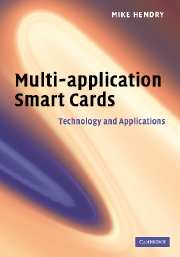Book contents
- Frontmatter
- Contents
- Foreword by Kevin Gillick
- Acknowledgements
- Part I Introduction
- Part II Technology
- 4 Biometrics
- 5 Security and cryptography
- 6 Card technology
- 7 Readers and terminals
- 8 Application selection: the ISO 7816 family
- 9 JavaCard and GlobalPlatform
- 10 Multos
- 11 Other operating systems
- 12 Card management systems
- Part III Business requirements
- Part IV Implementation
- Appendix A Glossary
- Appendix B Further reading
- Appendix C Standards
- Index
- References
7 - Readers and terminals
from Part II - Technology
Published online by Cambridge University Press: 11 August 2009
- Frontmatter
- Contents
- Foreword by Kevin Gillick
- Acknowledgements
- Part I Introduction
- Part II Technology
- 4 Biometrics
- 5 Security and cryptography
- 6 Card technology
- 7 Readers and terminals
- 8 Application selection: the ISO 7816 family
- 9 JavaCard and GlobalPlatform
- 10 Multos
- 11 Other operating systems
- 12 Card management systems
- Part III Business requirements
- Part IV Implementation
- Appendix A Glossary
- Appendix B Further reading
- Appendix C Standards
- Index
- References
Summary
The basic structure of a reader for contact cards was described in Chapter 3. This chapter considers the specific requirements of different sectors and of multi-application cards.
Reader type
In Chapter 3 we saw that readers may be manual or motorised, partial or full insertion, chip only or hybrid.
Motorised readers have specific advantages in multi-application environments too: the terminal can execute both ‘warm’ and ‘cold’ resets (see Chapter 8), allowing it to switch between applications without giving potentially confusing messages to the user or card-holder.
Many smart cards carry a magnetic stripe as well. This can be read when the card is inserted or when it is withdrawn; the former has advantages if some form of fallback is required, but reading a magnetic stripe on entry is often less smooth than reading on exit, and so gives slightly lower success rates. In retail environments where reliable reading of both chip and magnetic stripe cards is very important, special readers have been developed (see Figure 7.1) that combine a long reading slot for swiping with a ‘park’ position for reading the chip.
Contact readers must also have limit switches or other methods for detecting when a card is in place; these are used not only for powering up the card but also for detecting when a card has been inserted wrongly or not removed at the end of the transaction; in these cases it is often desirable for the terminal to emit a warning tone or signal.
- Type
- Chapter
- Information
- Multi-application Smart CardsTechnology and Applications, pp. 59 - 68Publisher: Cambridge University PressPrint publication year: 2007



